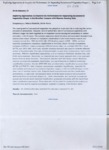Use este identificador para citar ou linkar para este item:
http://www.alice.cnptia.embrapa.br/alice/handle/doc/31673Registro completo de metadados
| Campo DC | Valor | Idioma |
|---|---|---|
| dc.contributor.author | LU, D. | pt_BR |
| dc.contributor.author | BATISTELLA, M. | pt_BR |
| dc.contributor.author | MORAN, E. | pt_BR |
| dc.date.accessioned | 2011-04-10T11:11:11Z | pt_BR |
| dc.date.available | 2011-04-10T11:11:11Z | pt_BR |
| dc.date.created | 2009-03-09 | pt_BR |
| dc.date.issued | 2008 | pt_BR |
| dc.identifier.citation | In: CONFERÊNCIA CIENTÍFICA INTERNACIONAL AMAZÔNIA EM PERSPECTIVA CIÊNCIA INTEGRADA PARA UM FUTURO SUSTENTÁVEL, 2008. Manaus: Conference Abstracts ... Brasília, DF: LBA, 2008. | pt_BR |
| dc.identifier.uri | http://www.alice.cnptia.embrapa.br/alice/handle/doc/31673 | pt_BR |
| dc.description | The rapid growth of successional vegetation has played an important role in reducing the carbon emission to atmosphere. However, lack of spatial data sets of successional vegetation with different stages has been regarded as an important source causing the uncertainty in carbon estimation in the Amazon. The complex vegetation stand structure and associated abundant tree species often induce difficulty in vegetation classification in the moist tropical regions with remotely sensed data. With the NASA LBA-ECO funding support (1998 - 2008), we have examined successional vegetation classification in Rondonia, Brazil, through comparative analyses of different image procedures. Different sensor data, i.e., Landsat TM/ETM+, Terra ASTER, and SPOT HRG, were used. Wavelet-merging approach was used to integrate different sensor or resolution data. The roles of textures based on grey-level co-occurrence matrix were examined. Different classification approaches, such as maximum likelihood, decision tree, and ECHO were examined. Meanwhile, we explored sub-pixel based approach and a new approach based on forest stand structure. This research indicates that data fusion cannot effectively improve successional vegetation classification, but use of textures is helpful in improving classification accuracy. Overall, SPOT HRG data provided better classification accuracy than ASTER and TM/ETM+ data. However, successional vegetation classification, especially for intermediate and advanced successional vegetation stages, is still very difficult based on the direct use of remotely sensed data. Subpixel based approach improved the classification performance. In particular, the approach based on forest stand structure can successfully distinguish three successional stages (i.e., initial, intermediate, and advanced successional stages) and provide much improved classification accuracies comparing with the result from other classification approaches. These data sets will be useful for conducting the scaling-up research from local to regional successional vegetation mapping in the Amazon basin. Tipo de Apresentação: Oral | pt_BR |
| dc.format | 1 CD-ROM. | pt_BR |
| dc.language.iso | por | pt_BR |
| dc.rights | openAccess | pt_BR |
| dc.subject | Dinamica florestal | pt_BR |
| dc.subject | Pertubações naturais | pt_BR |
| dc.subject | Amazonas | pt_BR |
| dc.subject | Lba-Eco | pt_BR |
| dc.title | Exploring approaches to improve the performance for separating successional vegetation stages in the Brazilian Amazon with remote sensing data. | pt_BR |
| dc.type | Resumo em anais e proceedings | pt_BR |
| dc.date.updated | 2015-01-12T11:11:11Z | pt_BR |
| dc.subject.thesagro | Regeneração | pt_BR |
| dc.format.extent2 | 1 p. | pt_BR |
| riaa.ainfo.id | 31673 | pt_BR |
| riaa.ainfo.lastupdate | 2015-01-12 | pt_BR |
| dc.contributor.institution | DENGSHENG LU, indiana University; MATEUS BATISTELLA, CNPM; EMILIO MORAN, INDIANA UNIVERSITY. | pt_BR |
| Aparece nas coleções: | Resumo em anais de congresso (CNPM)  | |
Arquivos associados a este item:
| Arquivo | Descrição | Tamanho | Formato | |
|---|---|---|---|---|
| 2311.pdf | 827.46 kB | Adobe PDF |  Visualizar/Abrir |









